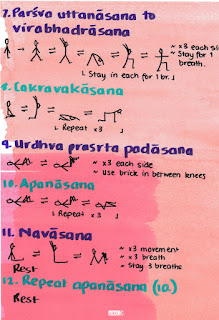The definition of the word yoga is one that
has many layers. When you ask most
people involved in yoga the definition of the word they often say “union”. And yes, one of the meanings of the word yoga
(which is a Sanskrit word derived from the root word yuj) is “to bring two
things together, to meet, to unite” (Desikachar, 1980). Another meaning has
similarities to the definition of samādhi which is “to converge the movement of
the mind” (Desikachar, 1980), that is to bring the mind to a single point of focus. A further definition offered by Desikachar in
his book Religiousness in Yoga is “to reach a point we have not reached
before”. In line with this, another
definition is offered – “to act in a particular way with all of our attention
focused upon that action” (Desikachar, 1980). And finally, one that is
often not discussed is “to be one with ‘God’” or the movement towards
understanding something higher than ourselves (Desikachar, 1980).
"Another important aspect of yoga has to do with action. Yoga also means "to act in a particular way with all of our attention focused upon that action." " ~ Desikachar, Religiousness in Yoga.
Let’s go back to the definition “to reach a
point we have not reached before”. This
movement from point A to point B is something we can relate to in all aspects
of life and what we can reflect, experience and explore in our yoga practice
through āsana, prānāyāma and meditation.
From week one we have been slowly developing our abdominal strength and
gradually intensifying our two goal postures: urdhva prasrta padāsana and navāsana. Now at week five, we can feel how our
strength has improved because the postures have developed to demand more from the body and
yet we can perform them with ease.
We have also been working on gradually
exploring the subtlety of the breath. We
have done this by first noticing the breath, then introducing the inhale and
exhale technique and extending upon this with the addition of breath
retention. Through this steady approach
to exploring the body and the breath we have had opportunity along the way to
reflect upon the changes.
We have been bringing this altogether at
the end of each class with a meditation to sharpen the mind’s attention. Over the five weeks, the meditation has
become more refined to build the mind’s ability to focus intently on a single
point. If we allow ourselves time to
reflect on how this five-week practice has impacted our body, breath and mind
we will notice that there has been a movement from one point to another.
Each practice I have designed with the
intention to encourage us to participate “…with all of our attention focused
upon that action”. This has been done
with each movement being anchored to the breath and by allowing the breath to
initiate the movement. As discussed in
my previous post by “consciously following the breath…we become one with the
movement” and to do this it requires our undivided attention (Desikachar, 1995). It also offers us a good
point of feedback because we will notice if the movement becomes mechanical
when the breath changes.
And finally, we may have had a glimpse in
this time of feeling in tune with something higher or beyond us. This often is experienced in our meditation
practice but can happen at any time. It
takes a certain awareness which is what is developed in our practice and
intensifies the more we practice or indeed perform our daily actions in a yoga
way. This is something that motherhood
has certainly helped me with – each moment is an opportunity to be fully
present with my son and to feel and be witness to something that seems beyond
this human experience.
This Tuesday will be our last class at
Bikram Yoga Kawana and we will be re-starting our Tuesday classes at Kawana
Island Meeting Place next school term.
Stay tuned via the blog and FaceBook (The Yoga Pod Sunshine Coast) for more
details.
Desikachar, T. K. V. (1980). Religiousness in Yoga: Lectures on Theory and Practice. United
States of America: University Press of America.
Desikachar, T. K. V. (1995). The Heart of Yoga: Developing a Personal
Practice. Vermont, United States: Inner Traditions International.















